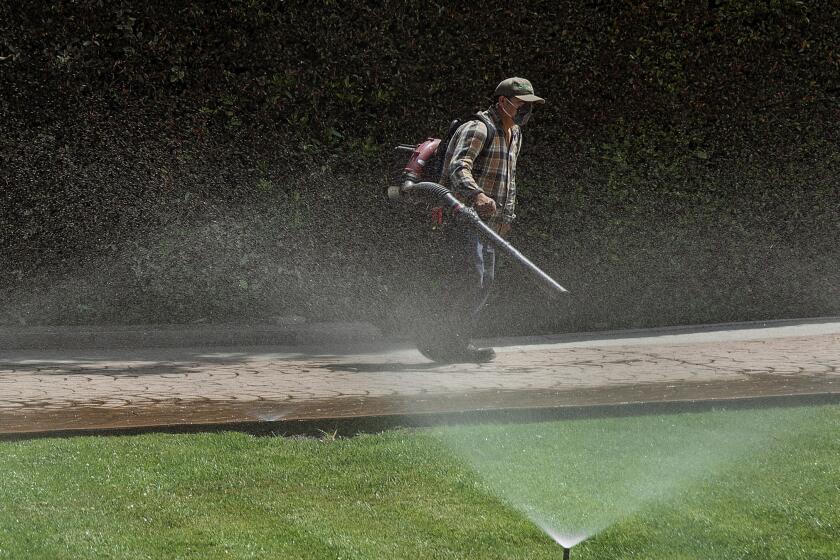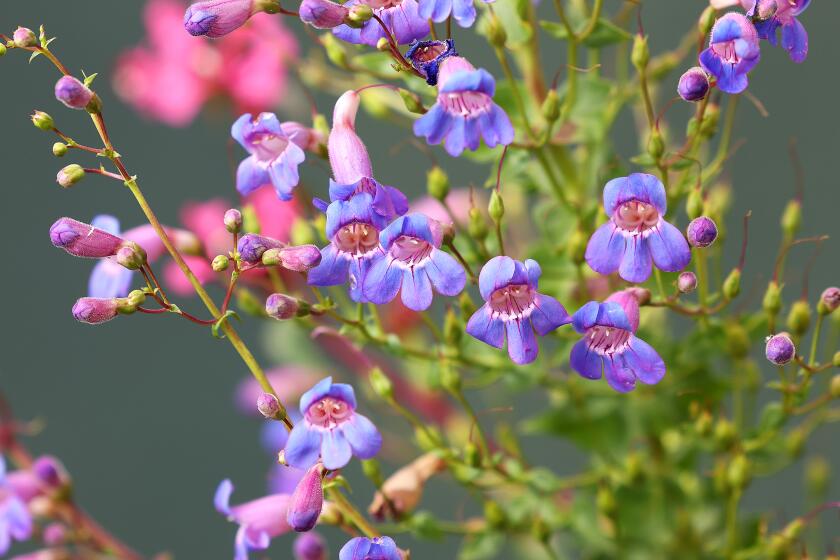The Plant Detective
- Share via
As with most of his patients, the latest case confronting David Lofgren has arrived in sick-looking pieces. An old plastic bagel bag holds all he’ll get to examine: one goopy wad of dark and not very pleasant-smelling foliage from an ailing bauhinia tree.
Since receiving it the previous afternoon, Lofgren has put the sticky mass under a microscope, consulted gardening encyclopedias and searched through a volume called “Diseases of Trees and Shrubs.” The bauhinia--a flowering warm-weather tree--shows none of the classic signs of insect damage nor any other helpful clues.
So what’s the diagnosis?
“Beats me,” concedes Lofgren, a horticulturist at the Los Angeles State and County Arboretum in Arcadia.
He vows to keep hunting. “I can solve most of them,” Lofgren insists.
The horticultural sleuthing takes place in a little-traveled corner of the arboretum where aspiring green-thumbs can, free of charge, call or drop by for advice on everything from waging war on cutworms to coaxing the best color out of that hydrangea. Marked as “Plant Information,” the office is often the stop of last resort for desperate gardeners with life-and-death worries about a certain botanical beloved.
“Just call this the ‘ER’ of plants,” says Lois Gronauer, a volunteer who fields calls. The hotline--(818) 821-3239--is open weekdays from 9:30 a.m. to 12:30 p.m. and gets about 5,000 calls a year.
The dozen or so volunteers attend monthly classes by Lofgren on the most common questions and how to answer them. Most, like Gronauer, are backyard growers and have learned survival tricks along the way.
She offers this one: Put your potted plants in a kiddie swimming pool with shallow water to keep them alive while you’re on vacation.
To answer the questions, volunteers turn to a handful of trusty plant books--the “Sunset Western Garden Book” is the favorite--or refer to the arboretum’s library holdings for more specialized queries. Lofgren, an avid plant collector who has served as the plant-information specialist for 15 years, handles the real posers.
Giving such advice requires patience and a healthy sense of humor, especially when dealing with nervous plant owners who can get emotional about a backyard tree they planted decades earlier. And callers have been known to be, shall we say, less than fully informed on things vegetative.
When a San Gabriel woman called in hopes of adding her 100-foot spruce tree to a registry of tall trees, Lofgren balked. He’d never heard of spruces near Los Angeles--could she check the needles to make sure? Needles? the woman asked. This tree had leaves, big ones. The tree turned out to be a sycamore--tall, perhaps, but certainly no rarity.
*
Then there are the Gardeners Who Love Too Much--the cause of half of reported plant problems. Clara Feldman, a West Los Angeles resident, for weeks fretted about her ailing citrus tree before making the trip to Lofgren’s office, toting some anemic leaves in a paper bag. She sat somberly across his desk as he examined the leaves and asked a few questions.
Lofgren’s answer: too much watering. It’s one he delivers frequently to well-meaning gardeners. Over-watering, he explains in a tone that would make Marcus Welby proud, can spawn a disastrous cycle in which the soggy plant begins to wilt, inviting its owner to--what else? Give it even more water.
But he understands the temptation to sprinkle.
“It’s like therapy for them. They think it’s good for the plants and feels good,” Lofgren says. But, he adds, “We’re not living in a rain forest.”
Other visitors simply want to get the most out of their gardens or identify weeds popping up in the backyard. Julia Dougherty arrives with a shopping bag full of specimens from around her Pasadena home. Her hydrangea, a shrub that normally blossoms in great snowballs of color, is too pale. And is it supposed to be lavender? Lofgren teaches her how she can get it to bloom pink by adding lime to the ground. Or for blue flowers, add sulfur.
Jean Maxeiner turns up with a more dire concern. The Japanese maple she planted as a seedling 45 years ago is stricken with some mysterious condition. The branches have ugly black stains and are splitting in places.
Lofgren, sitting before a climate map of North America, describes a tree mold that might explain the stains and runs through the eating habits of a type of bug that might be the culprit. Lofgren suggests that Maxeiner cut back the stricken branches and consider spraying for the insects.
“It would just be devastating to me if I’d lose this tree,” Maxeiner says.
Her husband, Don, seconded that. “She’d rather lose me,” he says.






